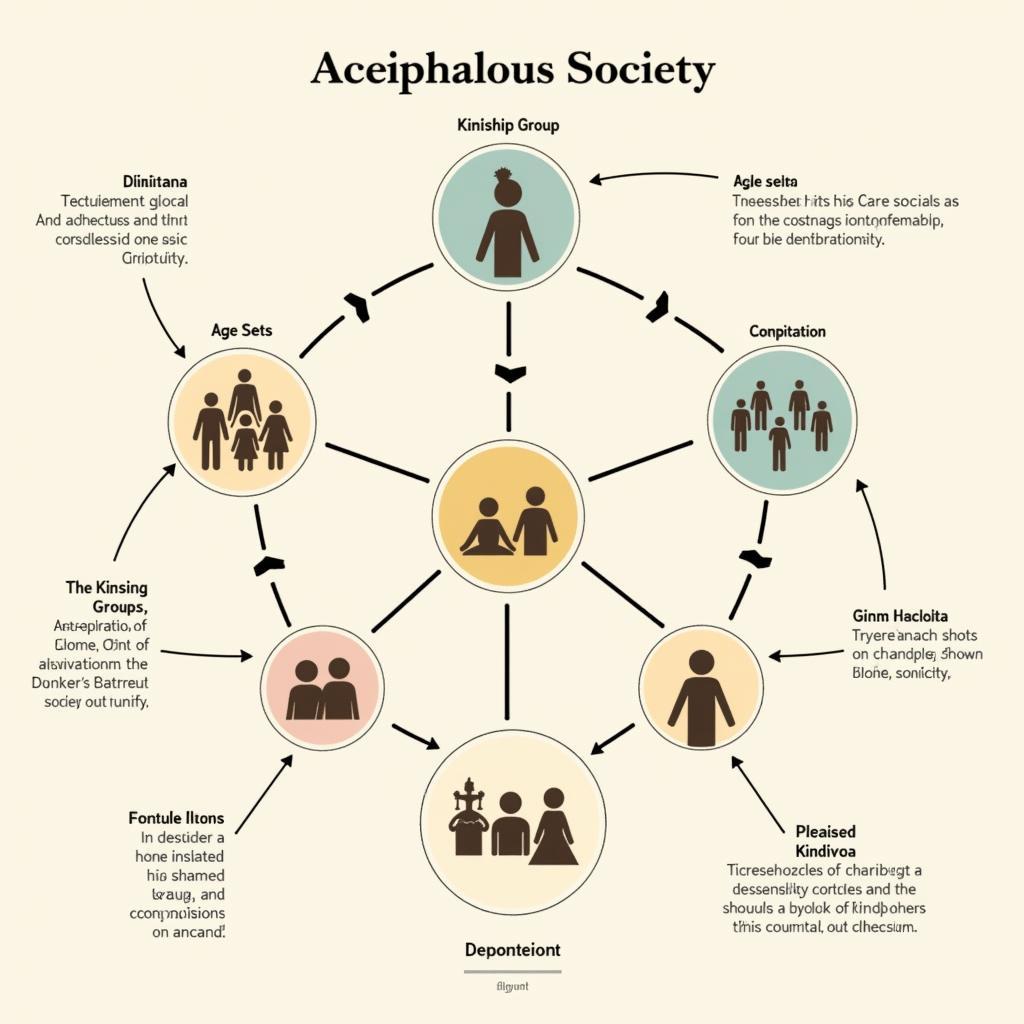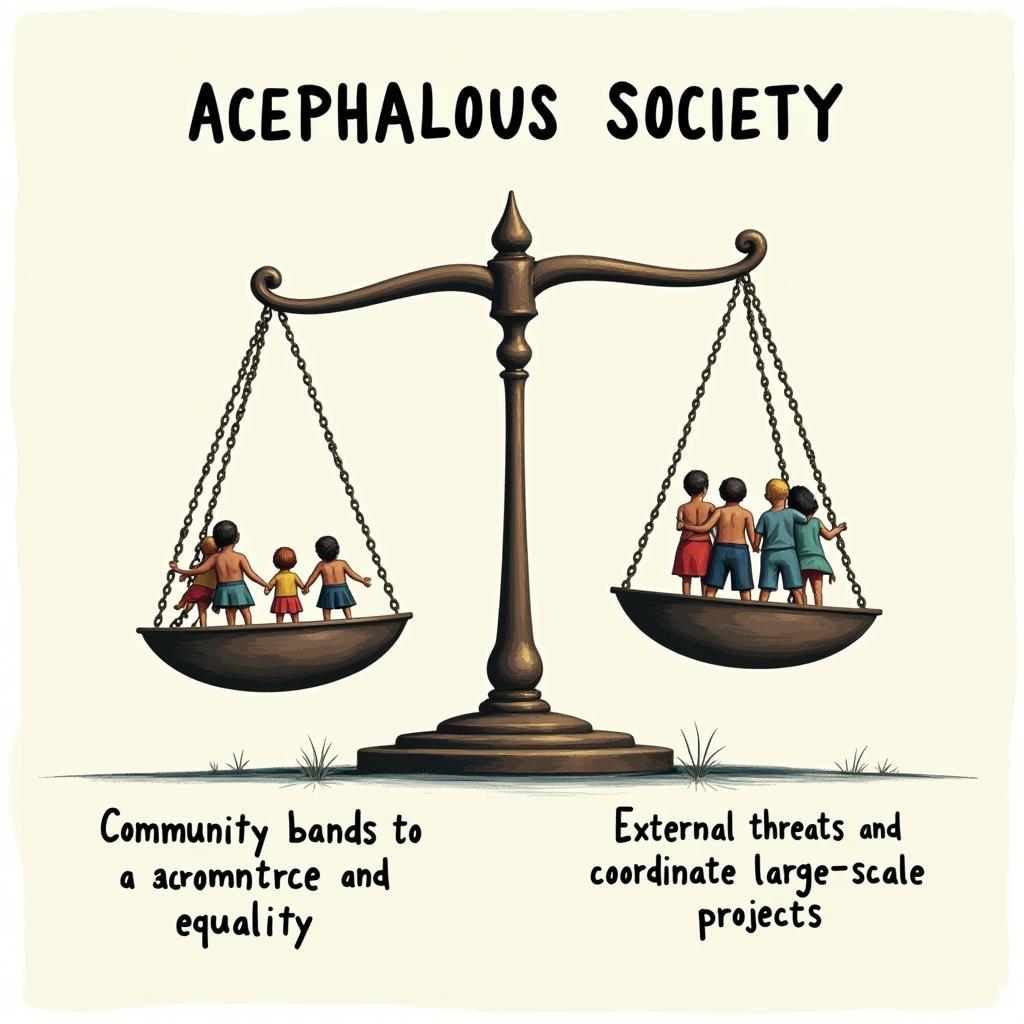Acephalous societies, fascinating social structures without centralized political leadership, offer unique insights into human organization. These communities, often misinterpreted as “primitive” or “lacking order,” demonstrate diverse methods of governance based on kinship, age grades, or other forms of social organization. This article delves into the complexities of acephalous societies, exploring their structures, cultural nuances, and the challenges they face in a globalized world.
Exploring the Dynamics of Acephalous Societies
The term “acephalous” derives from the Greek words “a,” meaning “without,” and “kephale,” meaning “head.” This literally translates to “headless,” reflecting the absence of a single, overarching political authority. Instead of a hierarchical power structure, acephalous societies rely on distributed authority and consensus-based decision-making. This can manifest in various forms, from councils of elders to complex systems of age sets and lineages. These systems, often intricately interwoven, maintain social order and resolve conflicts through established customs and traditions. What might appear chaotic from an outsider’s perspective is, in reality, a sophisticated network of social checks and balances.
The absence of a centralized government doesn’t equate to a lack of governance. Acephalous societies often have well-defined rules and regulations, enforced through social pressure, community sanctions, and spiritual beliefs. These societies demonstrate the resilience and adaptability of human communities to organize themselves effectively without relying on centralized power. They offer valuable lessons in self-governance and community cohesion.
 Acephalous Society Organizational Structure
Acephalous Society Organizational Structure
Diverse Examples of Acephalous Societies Around the World
Numerous examples of acephalous societies exist across different cultures and historical periods. Historically, the Igbo people of pre-colonial Nigeria practiced a form of acephalous governance based on kinship and village assemblies. Similarly, some indigenous groups in the Amazon rainforest continue to live in acephalous communities, relying on traditional knowledge and shared leadership to manage their resources and social life. The study of these diverse examples offers valuable insights into the diverse ways humans organize themselves politically and socially. Understanding these different models challenges our preconceived notions about leadership and governance.
Challenges Faced by Acephalous Societies in the Modern World
While acephalous societies showcase remarkable resilience, they face significant challenges in an increasingly interconnected world. The pressures of globalization, state expansion, and economic development often threaten their traditional ways of life. Land encroachment, resource exploitation, and the imposition of external political structures can disrupt the delicate balance of power and social cohesion within these communities. It is crucial to recognize and respect the autonomy and cultural integrity of acephalous societies, supporting their right to self-determination and cultural preservation.
How Do Acephalous Societies Make Decisions?
Decision-making in acephalous societies is often a collective process, involving discussions and negotiations within the community. This can involve councils of elders, lineage heads, or representatives from different social groups. Consensus building and respect for diverse perspectives are key elements of this process. The goal is to reach decisions that benefit the entire community, ensuring social harmony and stability.
What Are the Advantages and Disadvantages of an Acephalous Society?
Acephalous societies often foster strong community bonds and a sense of shared responsibility. The decentralized nature of power can prevent the abuse of authority and promote greater equality. However, the lack of a central authority can also make it difficult to respond to external threats or coordinate large-scale projects. Finding the balance between individual autonomy and collective action is a constant challenge for these societies.
 Advantages and Disadvantages of an Acephalous Society
Advantages and Disadvantages of an Acephalous Society
Conclusion
Acephalous societies, far from being relics of the past, offer valuable insights into human social organization. Understanding their complex structures and cultural nuances is essential for promoting cross-cultural understanding and fostering peace in a diverse world. By recognizing the value of these unique social systems, we can learn valuable lessons about governance, community, and the diverse ways humans organize themselves. Let us embrace the diversity of human experience and work towards a future where all societies can thrive.
FAQ
- What is an Acephalous Society? An acephalous society is one without a centralized government or a single ruling leader.
- How do acephalous societies maintain order? They rely on social customs, traditions, and community consensus.
- Are acephalous societies always peaceful? Like any society, they can experience conflict, but they have mechanisms for resolving disputes peacefully.
- Are there any acephalous societies today? Yes, although many face challenges from globalization and state pressures.
- What can we learn from acephalous societies? They offer valuable lessons in self-governance, community cohesion, and sustainable living.
- How do acephalous societies interact with the modern world? Many struggle to maintain their traditions while adapting to external pressures.
- What are the key characteristics of an acephalous society? Decentralized power, consensus-based decision-making, and strong community ties.
Need support? Contact us 24/7: Phone: 02043854663, Email: [email protected], Address: Khu 34, Bac Giang, 260000, Vietnam.
We also have other resources on related topics on our website. Please explore our articles on traditional governance systems, indigenous cultures, and conflict resolution.